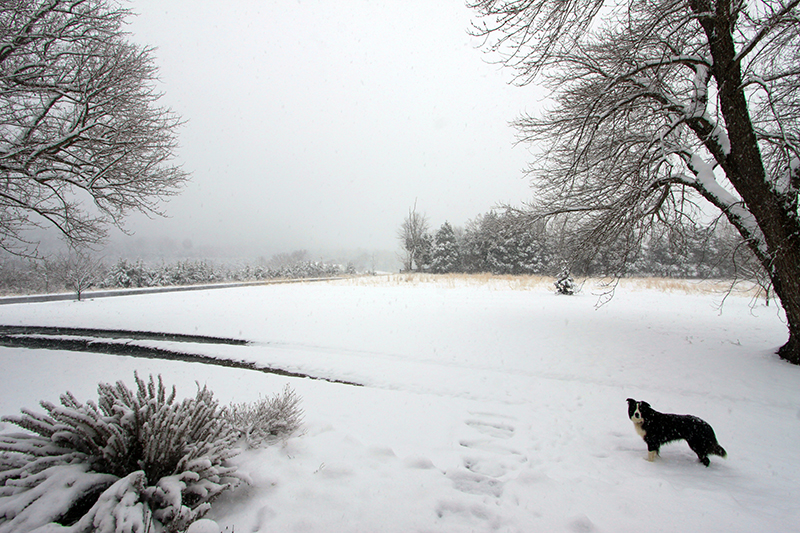January 17th, 2015 §

Even though I now live 3,570 miles away from my farmdog, I think about him all the time, especially when I see a black and white shepherd here in Edinburgh—which is about every day given that this is the land that originated the breed. Ancestors of the English Shepherd went to the New World with the colonists, where they were developed into all-purpose American farm dogs.
Interestingly, the breed “English Shepherd” isn’t known as such here in the U.K. unless dealing with a specialist breeder. A quick glance around the internet reveals that some U.K. breeders are importing English Shepherds from the U.S. for their breeding programs, touting the benefits of these “American” dogs. What goes around, comes around, right? Here’s the clearest explanation I’ve seen of the origins of the breed and how it developed. Right now there are only three U.K. English Shepherd breeders listed on the U.K. English Shepherd Club Web site. Maybe Tuck has a future here as a stud dog?
As much as I am sure he’d like that, Tuck is doing great living with my parents, where he has everything he needs plus the added benefit of canine cousins. Tuck grew up a wild child in a Free Union holler’, homeschooled by an eccentric and reclusive single parent—this new socialization is good for him. As dogs do, he’s adapted to and accepted his new reality without a backward glance, which is all I could hope for. Happy fourth birthday, farmdog.
Past birthdays: Third birthday, second birthday, first birthday.
(Thanks to Dad for the photo, and all the regular updates.)
August 6th, 2014 §
It took me a long time to get used to having a dog that constantly keeps his eye on me, even when pretending to relax. At best it is intense, at worst somewhat creepy. But now after three and a half years of living with my “English shadow” I am having a hard time imagining Tuck not having my back at all times.
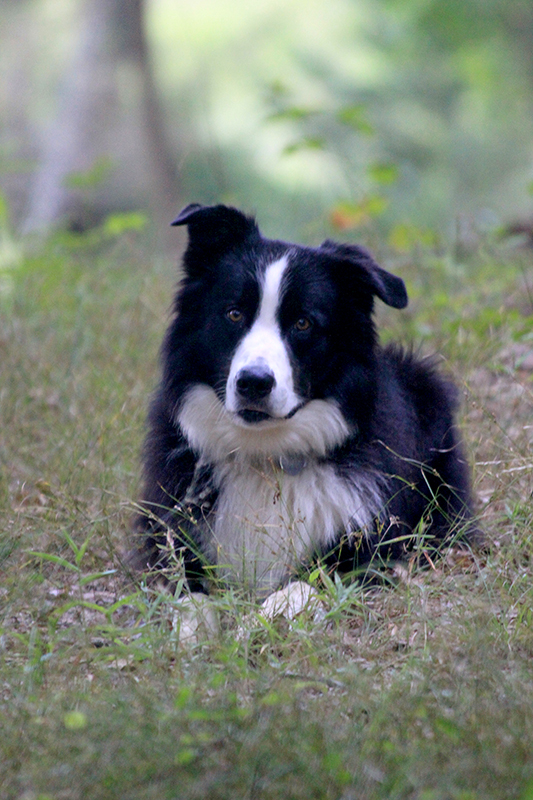
Last night he watched me as I prowled about the woods, photographing the surprise lilies. He came right to the edge of his invisible fence line, as I walked beyond it, and didn’t budge.
Sometimes Tuck is silly, often he is playful and excitable just like a typical puppy. Sometimes he is the purest expression of wild joy that I have ever seen, flying at full speed across the field first thing on a cool morning. But ever since I have known him he’s also had a serious, contemplative side, and that’s the Tucker I saw last night—his old-soul face. I wonder what he knows.

July 24th, 2014 §
The year’s first wren nesting didn’t work out too well. But the wrens are back, this time having set up a much more concealed nest in one of my planters on the front porch. I am doing my part, this time, by surrounding the planter with a fortress of porch chairs and ladders, all positioned to keep Tucker away. Thus far it’s working. I’ve got four baby wrens growing up on the porch. Their nest is so deep in the planter that it took a flashlight to get this shot.
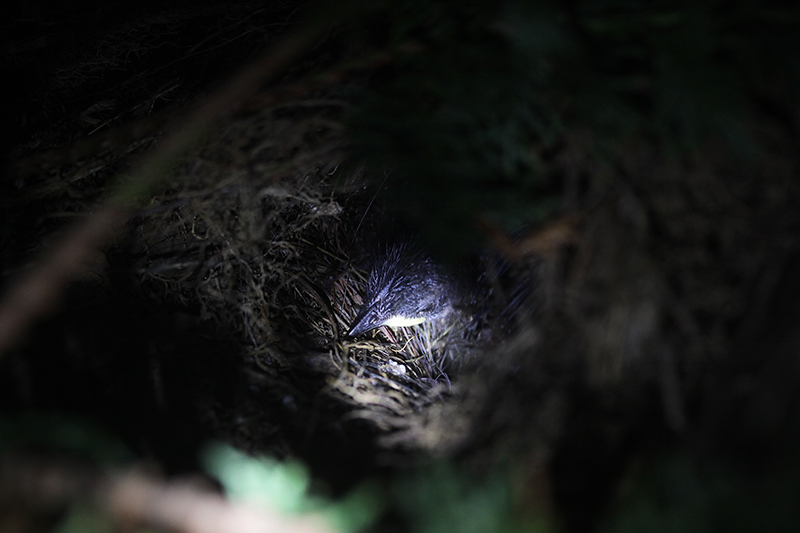
July 20th, 2014 §
After the interminable cold of last winter, I am making a conscious effort to gorge on summer with both beautiful, fresh foods and warm-weather experiences. Already it’s the end of July: I saw my first reddening maple this week and the locust trees are browning out—both surefire reminders that we’re slipping toward darker, colder days.
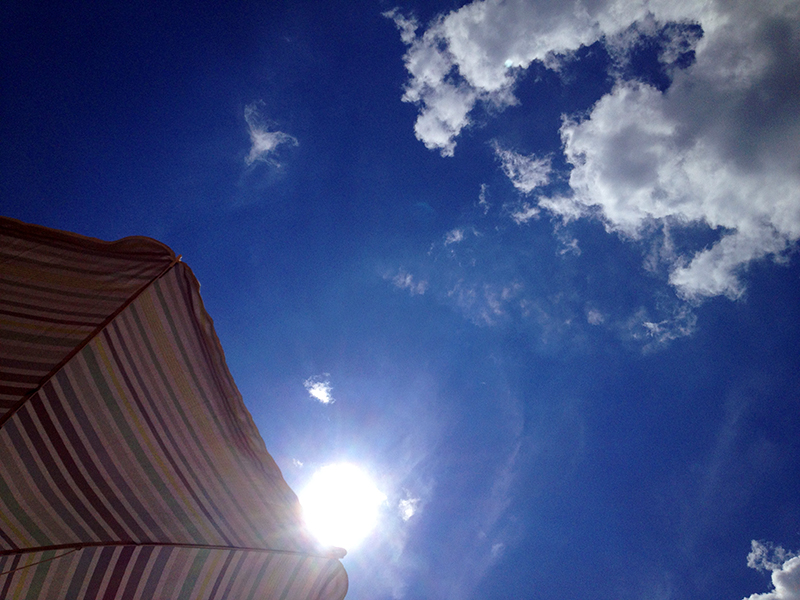
Last week I spent the afternoon at a nearby lake beach, swimming with a friend and her three small children. It was so much fun but what a workout supporting two nonswimming kids at a time in the water while making sure no one drowned! I brought about ten pounds of cut-up watermelon and we polished it off. Sandy watermelon definitely screams summer.

Then Friday I took a date and his dog hiking in the mountains. Tuck got to swim and run trails all day with the first female dog he’s spent much time with, and I think he’s in love.
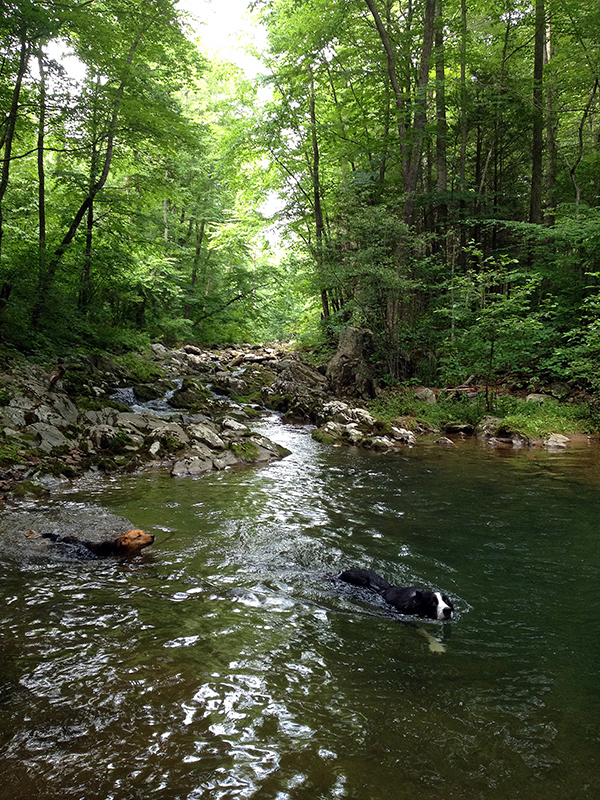
Humans and canines enjoyed a big swimming hole in a shady, mossy glen way up on the mountain, and during our picnic I met a new-to-me butterfly, the Zebra Swallowtail, that flitted around us for hours. It was my favorite colors—pale aqua and coral. It felt great to spend two days in a row swimming in natural bodies of water.
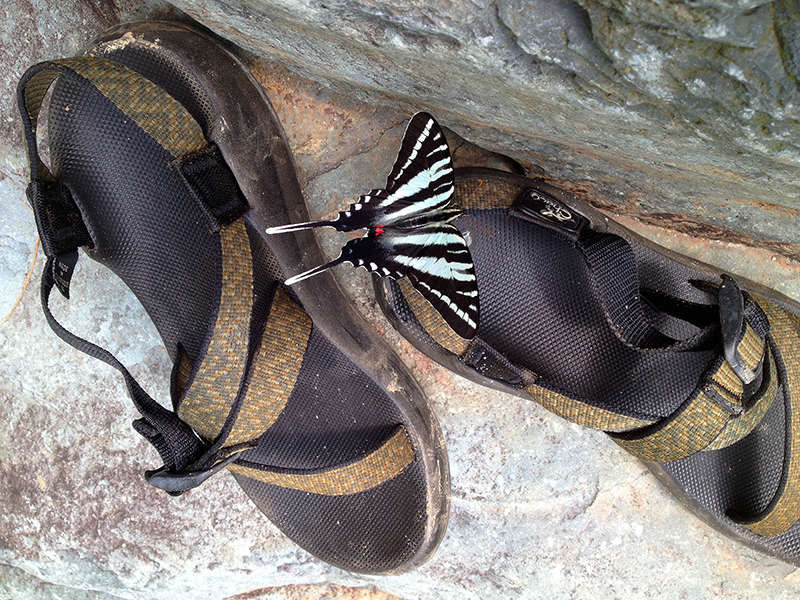
Yesterday was cloudy and cool, so I cooked all afternoon in front of the open windows, listening to the bird life outside. I roasted a bunch of cherry tomatoes, which are ripening in overwhelming succession, caramelized onions for about 45 minutes, and blanched the year’s first little “Nickel” green beans. All that plus a handful of chopped basil and some shredded provolone went into a quiche made with my chicken’s own eggs, and it was the best quiche I’ve ever made. And it didn’t even include my usual bacon or sausage!
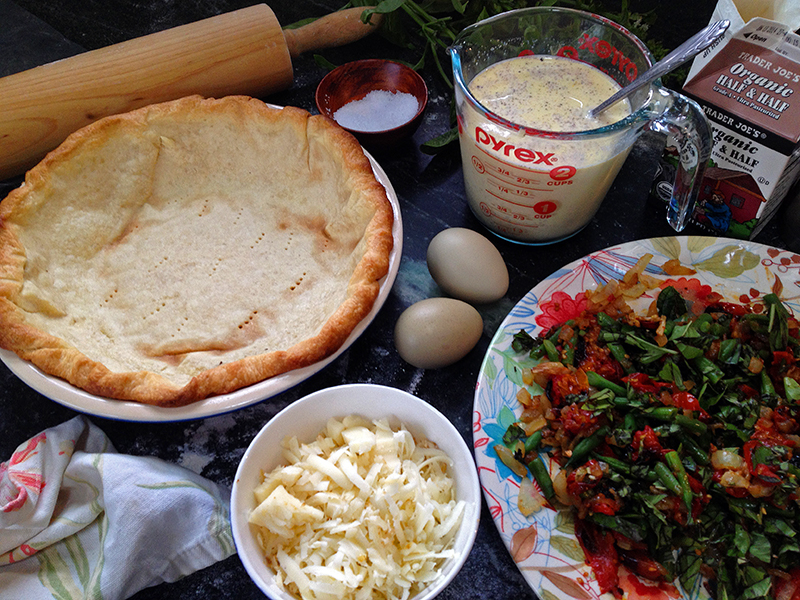
I think, after years of experimenting, I’ve found a good crust recipe. I’ve never been particularly in love with any of my crust recipes, but this one worked perfectly. And it’s so easy I can write it here from memory:
145 grams of flour
1 stick of butter, roughly chopped into 1/8″ pieces (my butter was frozen, and it was fine)
1/2 tsp. kosher salt
3 tbs. ice water
Spin flour and salt in food processor, then add butter and process to coarse crumbs. Dump in all the ice water and then—here’s where it goes against other recipes I’ve used—process regularly for about 30 seconds. It will feel like you are overprocessing, but the crumbs will come together into a perfectly smooth dough right at 30 seconds. Stop as soon as that happens, take out, shape into a disk and chill. Overnight is recommended but I just did it for an hour and it was still okay. Then roll out, dock, and blind bake for 15 min at 450 degrees. Cool, fill and bake again with whatever you want in it. Easy—and a life victory to have finally lit upon a recipe and technique that worked well!
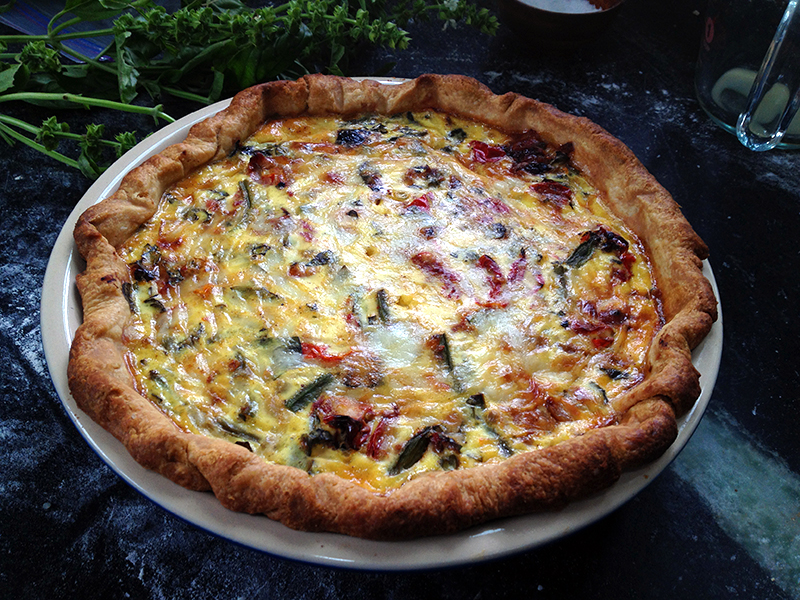
While the quiche was baking I threw together a couple of jars of refrigerator pickles. We have entered the time of year when it’s hard to keep up with the garden’s output, but I love the challenge of having to turn tons of produce into meals.
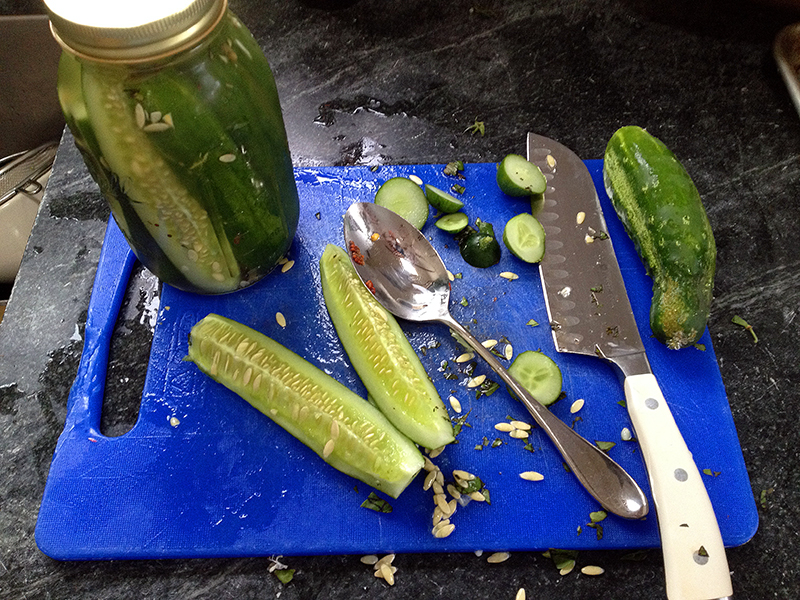
Speaking of which, my garden/kitchen task today is to shred and freeze squash. I think I will also attempt a savory zucchini bread—the weather is so cool that it’s a good weekend to have the oven running!
And then maybe, hopefully, my dog and I will find our way to a river. Because it’s summer, and the season for swimming.
July 4th, 2014 §
From your friends in Free Union—where this English shepherd and some suspiciously British-looking bunting hopefully don’t give us away! We’re patriots, despite appearances to the contrary! We swear!
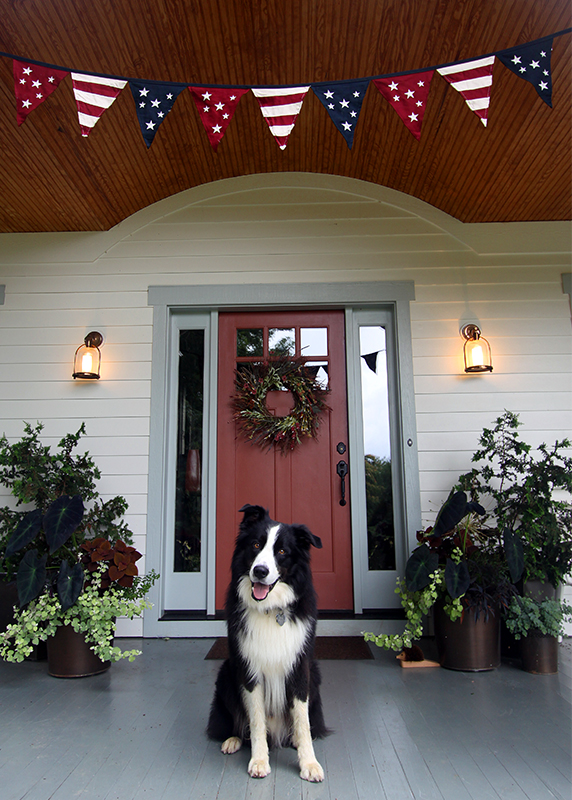
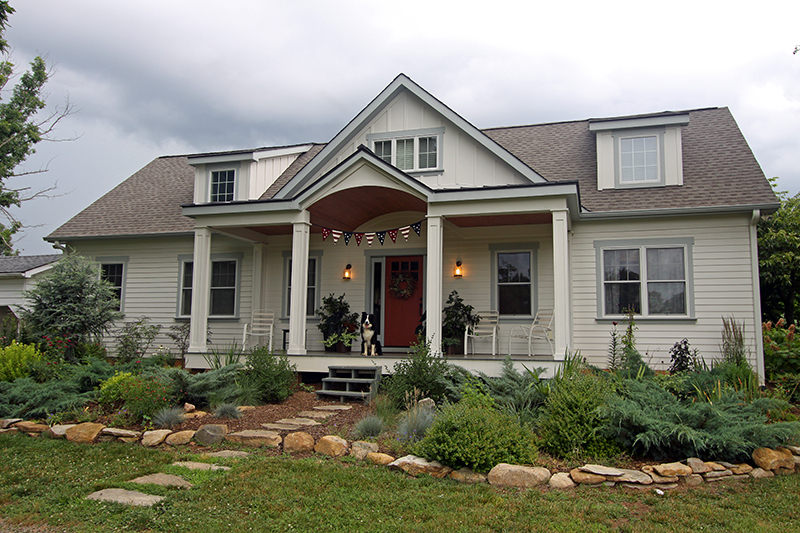
(Even if we do love England.)
June 25th, 2014 §
Look who bounded in the house last night, keyed up like all get-out, covered forehead to paws in skunk juice, as I was all showered and in my pjs and ready to go to bed? At least he took it like a man and was only shot down his front and not all over. So last night at 10:00 p.m. I was doing emergency bathing in a little puddle of floodlight.
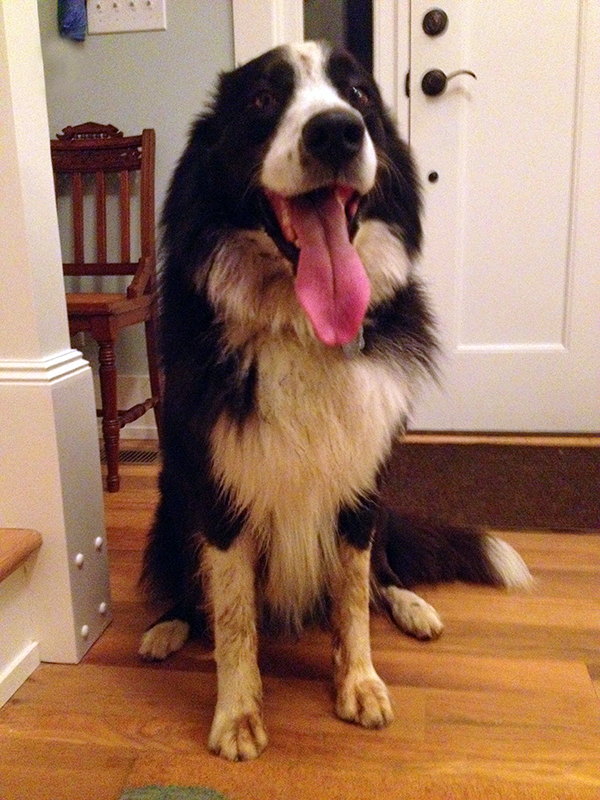
I suppose I shouldn’t complain too much. The last time Tuck was skunked was May 2012, which isn’t too bad for living in the wilderness. At least now I have my act together to run a hot water hose out of the laundry room, so I don’t have to do cleanup in the house.
One word: Technu. It’s that poison ivy, outdoorsman soap that combines with and removes nasty oily stuff. After the last skunking, I’d bought a bottle for just such an emergency, and boy, does it work. I rubbed it into Tuck’s fur and it seemed to instantly neutralize the skunk smell in a way that the dish soap and vinegar I used last time didn’t. I followed up with a regular dish soap wash and this morning he smells pretty decent, all things considered. Interestingly, the Technu wasn’t as effective at removing the smell from Tucker’s invisible fence and nylon collars, which still smell pretty skunky.
There are some recipes for homemade skunk smell remover online, but they use hydrogen peroxide. As the owner of a black dog, I didn’t want to play amateur beauty parlor and end up with a bleached-out pet!
May 31st, 2014 §
Creeps up from the creek and across the field.

May 30th, 2014 §
For weeks I’ve been watching a little house wren sit on a tidy nest in a front-garden shrub. I’d found the nest with my spade raised to prise the bush from the ground for relocation. Four blue, brown-speckled eggs popped into view, tucked just inside.
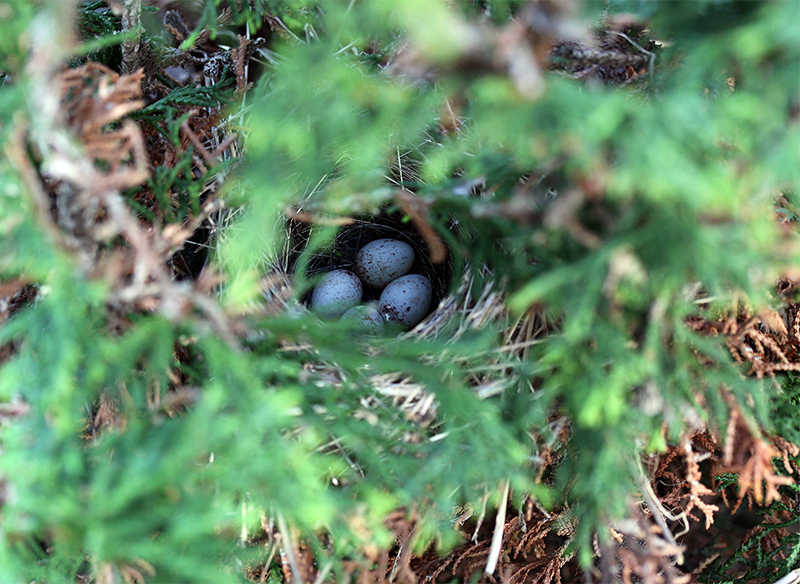
Obviously, landscaping was postponed, and each day I checked on the nest, always expecting the eggs to be gone. They were precariously sited in a bush not two feet off the ground, easy pickings for a snake or raccoon or possum. I considered surrounding the bush with some sort of barrier, but knew that the only thing that would keep a snake out was fine netting. I learned my lesson last summer when a large black snake got stuck and died in the netting I installed to protect the garden from the chickens. So I chose not to intervene with the nest.
Without any “help,” the eggs persisted, and two days ago the mother wren didn’t fly off the nest when I approached. She flattened her body in place, with only her brave eyes moving, and I knew her eggs had hatched.
Yesterday I went out to feed the chickens and saw Tucker bent over something in the grass. I knew that posture. Immediately I checked the nest, and it was empty.
I went back to where Tuck had been standing and searched the dewy clover. I found two little bodies, perfectly bloodless and still warm. I picked them both up, and they curled together in the palm of my hand as they must have in the nest. I almost felt their hearts beating against my skin, but knew it was only wishful thinking. Nearby the mother bird swooped and chattered, scolded and cried.
I buried the babies in a scrape of dirt, and went on with my chores, silent and avoiding eye contact with my dog. Of course I was sad but I had no right to be angry. I knew Tucker was only doing one of his jobs, hunting. A wild baby bird in an ill-positioned nest is to him no different than a rabbit flushed from the wellhouse or mole dug out of the pasture, and all are fair, encouraged game.
As I’d wrapped up the chicken chores I moved some flats of seedlings out of the shed into the rain. I glanced down and saw that my crepe myrtle, still in its gallon nursery pot, had leafed out by several inches from the base.
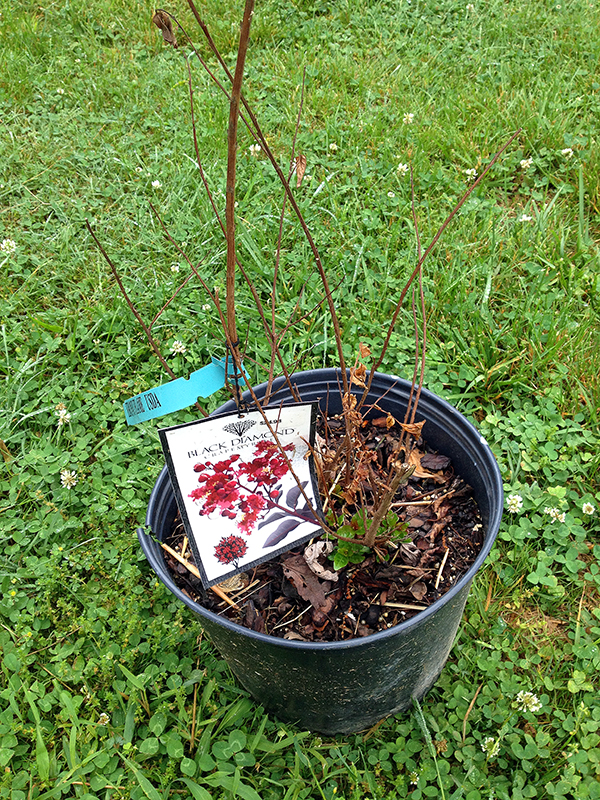
Seems reasonable until I tell you that I’d tortured this plant all last summer, letting it go bone dry and sunburned, as I prevaricated about where in the ground to stick it. And then summer became fall became our incredibly cold and snowy winter, all during which the pot of dead sticks sat unprotected outside of the wellhouse. I was disappointed in myself that I’d killed a perfectly good future tree by not being able to make a simple, timely decision, and just a few days ago I had accepted my crepe myrtle was toast and mentally pitched it on the compost pile.
But in that short interval between intention and action this forsaken plant had quietly, and on its own schedule, conveyed to me its plan to live.
Doing or not doing. Both are choices, and the joke of this choose-your-own-adventure is that we’re all just bumbling along. In a span of five minutes I got a perfect lesson in acting and not acting, and how each movement’s consequences can be both predictable and surprisingly unexpected.
I am going outside now to plant a crepe myrtle.
April 30th, 2014 §
It’s rained for three days and nights, downpours and thunderstorms, and it feels as though this little pocket of central Virginia has become Seattle. The mists lift and drop, playing peek-a-boo with the mountains, and all the new spring greenery is positively glowing in the excess moisture.
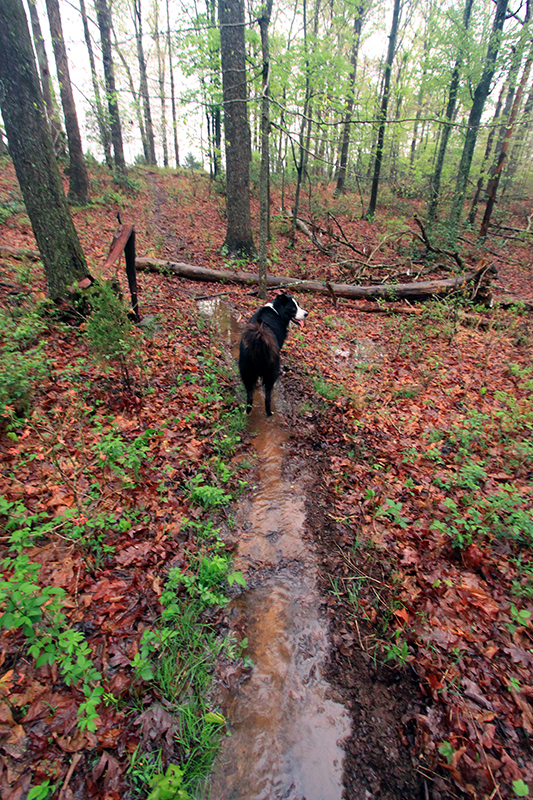
I took a short walk through the woods behind the house this evening, and discovered that Tucker’s trail has become, much to his delight, a creek. My Labrador in sheepdog’s clothing is thrilled that the stream has somehow migrated up the hill to within his reach. He zooms along it, mud flying everywhere. It’s so fun to watch his joy in the water that I can’t even be mad at how filthy he’s getting.
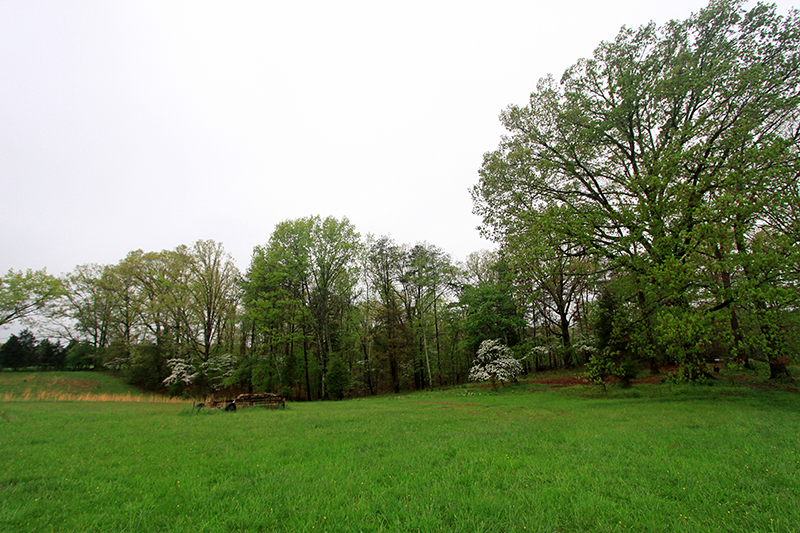
The woods are laced with our native dogwood, state tree of Virginia, and they look spectacular this year. It’s next to impossible to get a good shot of them in the woods, but in person they are stunning—ethereal white blossoms threaded through the entire forest. And look at that grass—technicolor! Methinks I will have the season’s first date with the mower this weekend, if the ground dries out enough to get on it with a big machine.
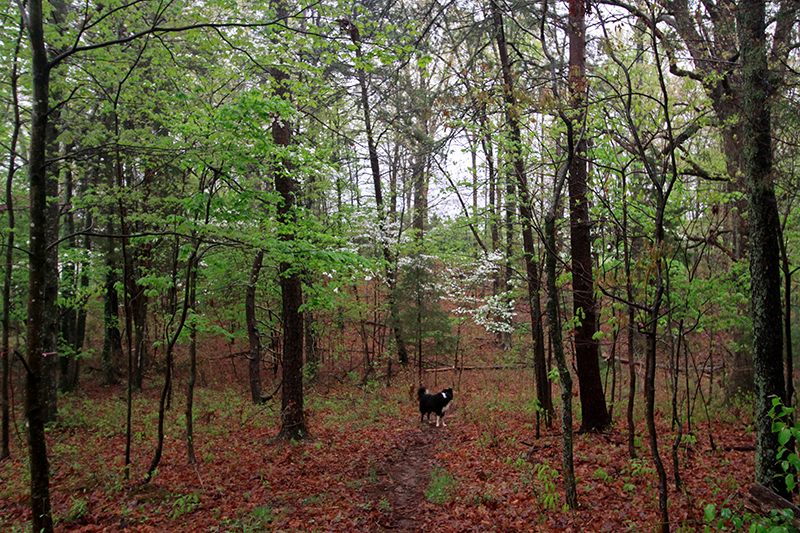
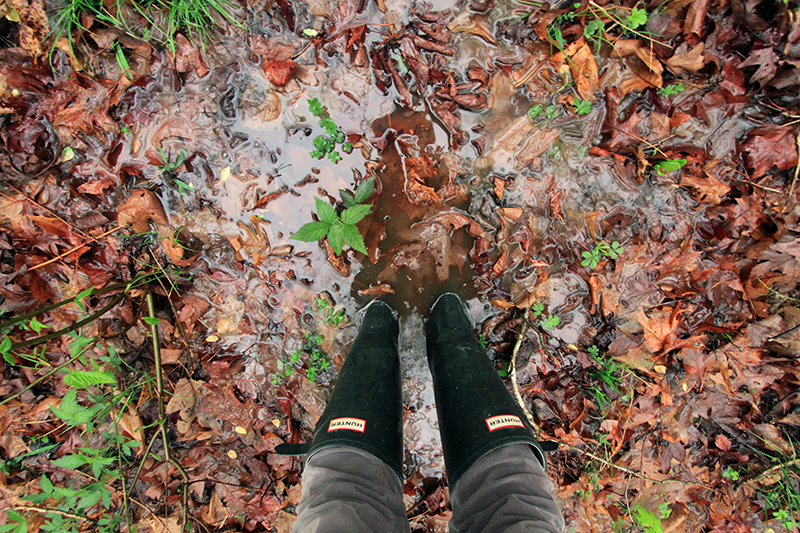
The middle of the woods, where it’s usually just dry forest duff, is now full of little ponds—this one deep enough to swallow my feet!
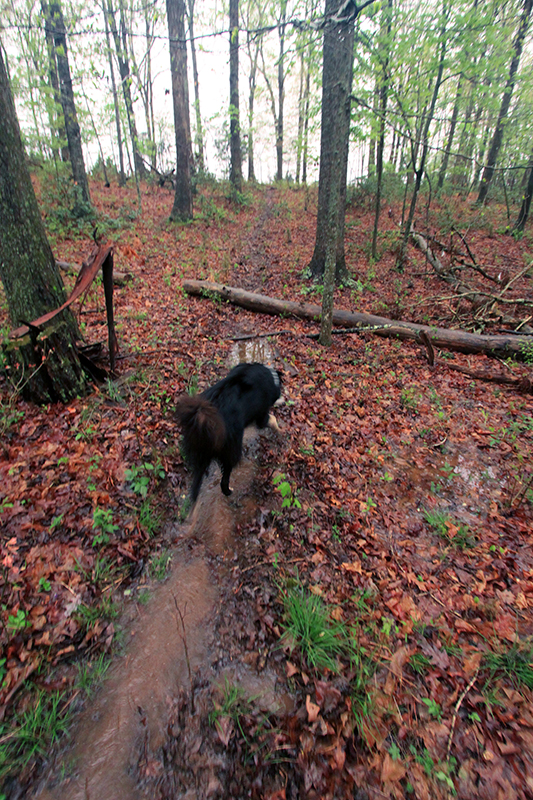
I can’t understand why the water collects as it does here, instead of continuing to run down the hill to the creek. A mystery I’ll never solve.
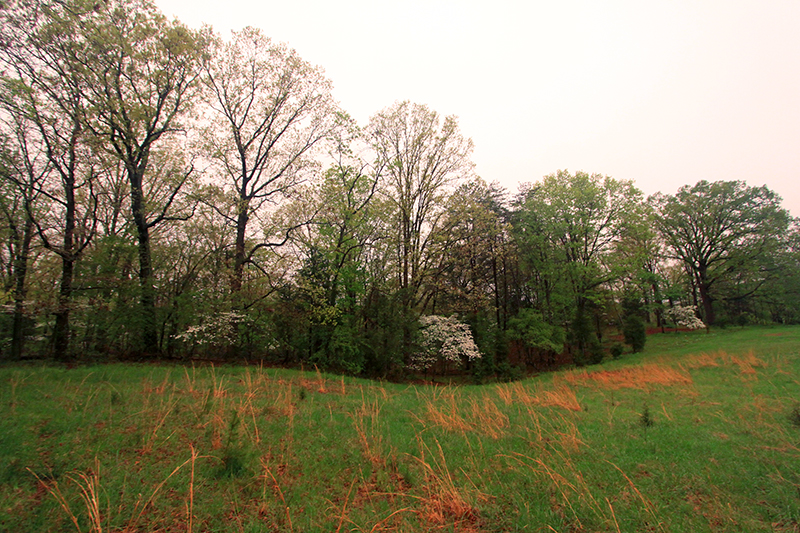
More dogwoods at the wood line, with the big oaks just leafing out above them. I love the gentle curves of this piece of ground. They remind me that I am lucky enough to live in the foothills of the Blue Ridge mountains.
March 25th, 2014 §
























